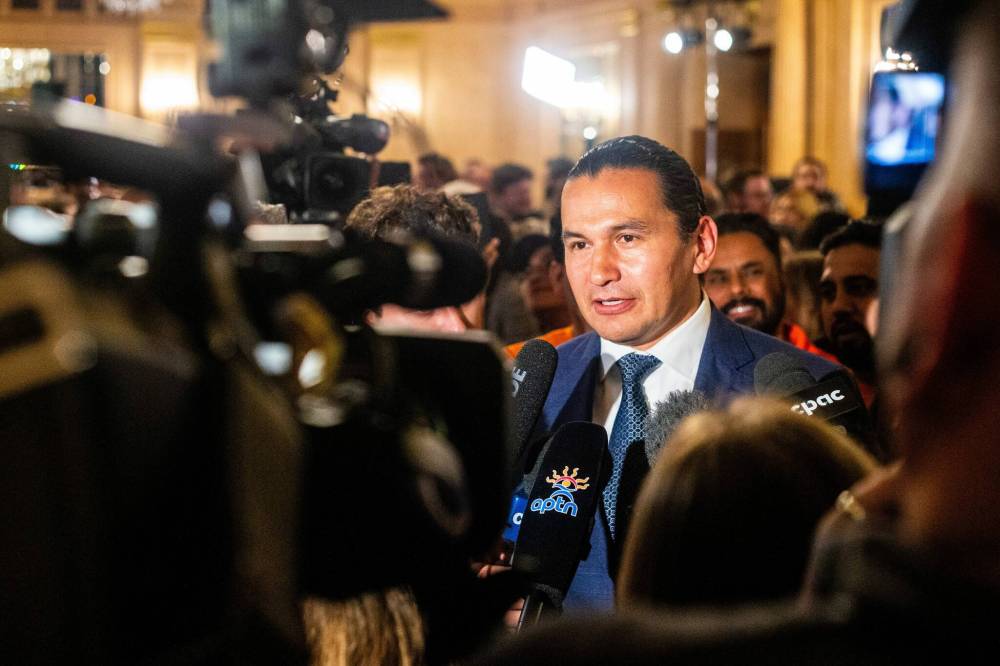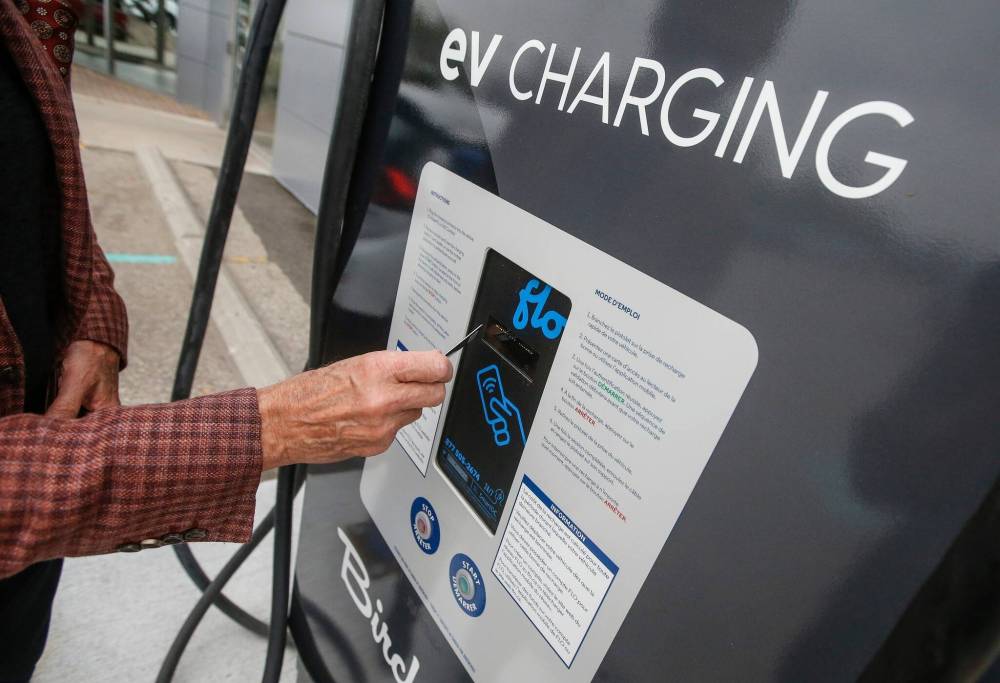Incoming NDP government’s climate agenda missing key details
Advertisement
Read this article for free:
or
Already have an account? Log in here »
To continue reading, please subscribe:
Monthly Digital Subscription
$0 for the first 4 weeks*
- Enjoy unlimited reading on winnipegfreepress.com
- Read the E-Edition, our digital replica newspaper
- Access News Break, our award-winning app
- Play interactive puzzles
*No charge for 4 weeks then price increases to the regular rate of $19.00 plus GST every four weeks. Offer available to new and qualified returning subscribers only. Cancel any time.
Monthly Digital Subscription
$4.75/week*
- Enjoy unlimited reading on winnipegfreepress.com
- Read the E-Edition, our digital replica newspaper
- Access News Break, our award-winning app
- Play interactive puzzles
*Billed as $19 plus GST every four weeks. Cancel any time.
To continue reading, please subscribe:
Add Free Press access to your Brandon Sun subscription for only an additional
$1 for the first 4 weeks*
*Your next subscription payment will increase by $1.00 and you will be charged $16.99 plus GST for four weeks. After four weeks, your payment will increase to $23.99 plus GST every four weeks.
Read unlimited articles for free today:
or
Already have an account? Log in here »
Hey there, time traveller!
This article was published 04/10/2023 (790 days ago), so information in it may no longer be current.
While it didn’t generate many promises or juicy soundbites on the election trail, there’s no doubt change is coming to the environment and climate file with the election of an NDP government this week.
NDP Leader Wab Kinew made it clear from the outset that climate change is on his radar.

“You will not have to fight me to take action on climate change. Instead ,we will fight together against global warming,” Kinew said in August.
The party’s climate policy is still riddled with gaps. Here’s what his government will mean for Manitoba’s environment.
Manitoba election results indicate carbon pricing won’t go to court; provincial fuel prices are still set to drop
It’s official: Manitoba will not go back to court over carbon pricing, but there is still a plan to keep the price of gas — and power — under control.
Manitoba’s NDP pledged to put a temporary freeze on utility rates, meaning electricity and natural gas bills shouldn’t increase in the coming months. The party also promised to temporarily axe a 14-cent-per-litre flat fee the province collects at the pump.
Energy prices were in focus throughout the campaign, as the Tories promised to challenge the feds in court over carbon pricing — for a second time. The NDP didn’t wade far into the fray on carbon levies, but Kinew said he would aim to have a larger share returned to provincial coffers and would work collaboratively — rather than combatively — with the feds to “bring home a better deal for Manitobans.”
Manitoba will create a net-zero 2050 strategy
The NDP has committed to a carbon-neutral economy, but it’s not clear what that will look like.
While in power, the Progressive Conservatives never agreed to a net-zero strategy, instead releasing energy plans touting the predominantly hydroelectric power grid and remaining committed to natural gas.
Although it’s true Manitoba’s 97-per-cent electric grid helps the province rank among the-least polluting provinces in the country, advocates have long stressed there’s work to do to reduce pollution from transportation and heating.
Manitoba Hydro power lines just outside Winnipeg. (John Woods / The Canadian Press files)
The NDP has promised it’ll chip away at carbon pollution while creating new jobs designed to weather the shift to a carbon-neutral economy. The party has made cursory commitments to reducing emissions to 45 per cent below 2005 levels in the next seven years, updating Efficiency Manitoba’s mandate to include emission-reduction targets and providing more funding for public transit, active transportation, waste reduction and urban forests.
The party has also promised to restore funding to environmental non-profits that had been clawed back under the PC government.
So far, the party has suggested it would develop a clean energy hub to expand Manitoba Hydro’s electric capacity, introduce new hydrogen-power generation projects and leverage the province’s manufacturing industry to make green energy a reality.
But those are ideas — not a formal plan.
Rebates to abound for electric cars, geothermal power
Amid a campaign full of promises to put more money in Manitobans’ pockets, the NDP pledged a handful of programs to “make it affordable to do the environmentally friendly thing” — especially when it comes to vehicles and home energy.
Under the new leadership, rebates will be offered for electric or hybrid vehicles: $4,000 for new cars and $2,500 for used vehicles. Kinew emphasized the goal is to make electric cars accessible to lower and middle-income households.
An electric vehicle charger at a GM dealership in Winnipeg. (John Woods / Winnipeg Free Press files)
He acknowledged the extra pressure electrification will put on the power grid, promising plans down the line to expand provincial power capacity.
The party has also pledged 5,000 homes will be hooked up to geothermal heating loops — currently considered one of the least polluting and most cost-effective ways to regulate indoor heat — free of charge.
The NDP estimates this will cost $130 million but generate significant return on investment. To realize this commitment, the party has promised to invest $5 million to build a workforce trained to install geothermal systems. The party estimates this will generate upwards of 1,000 new clean energy jobs.
More protected areas to come as Manitoba finally sets sights on 30-by-30 targets
Manitoba’s woeful record on protected areas might be set to change, as the NDP has promised to protect 30 per cent of lands and waters by 2030.
The Tories refused to adopt international protection targets, made glacial progress expanding protected areas, weakened protections in provincial parks and claimed conservation goals would dampen economic development.
The NDP will mark a distinct change in course.
The party has committed to creating a conservation action plan, including steps to protect wildlife, waterways, wetlands and peatlands. It will support the work to establish Indigenous Protected and Conserved Areas.
The NDP has also promised to stop the slow drip of privatization in provincial parks. It’s not clear whether mineral exploration — currently allowed in many parks — will still be permitted.
Under the previous government, the protected areas initiative had been reduced to one full-time employee working out of the natural resources department while parks staff, resource officers and other environment officer positions had been cut back considerably.
Asked in August whether he would restore staffing to conservation initiatives, Kinew said “repairing the damage of the cuts is a challenge that is going to take many years to accomplish,” but made no specific commitments.
Future of mining projects uncertain as NDP makes few commitments
The rumbles of an impending global energy transition have generated significant interest in minerals deemed essential to a low-carbon economy. Many of these minerals — particularly lithium — are found in abundance in Manitoba.
The previous government was setting the stage for a critical mineral boom, offering a host of financial incentives and promising to eliminate regulatory hurdles.
It’s part of why the PC government wasn’t too keen on protected areas; the prospecting industry has been pushing for a suspension of protected areas to allow no-holds-barred exploration.
The NDP has pledged to create its own critical minerals strategy in partnership with Indigenous communities, but has not outlined any details. The party has remained fairly mum on the mining front, and it remains to be seen whether they will continue to boost the mineral industry — which tanked under the last NDP government — or impose more restrictions in the name of environmental protection.
It’s likely to be business as usual for Sio Silica mining proposal
At a news conference in mid-September, two Springfield town councillors announced an independent survey of more than 5,000 Manitobans had found more than 95 per cent oppose Sio Silica’s proposal to mine sand from the community’s drinking water aquifer.
But the future of Sio Silica’s project remains uncertain.
Like his Tory counterparts, Kinew has taken a neutral stance on Sio Silica, deferring decisions about the controversial project to the technical advisory group tasked with reviewing the Alberta company’s proposal to drill nearly 8,000 wells.
The project generated enough public backlash to be referred to the Clean Environment Commission — Manitoba’s independent environmental regulator — for review. The commission found the mine could benefit the province (silica sand is used in several green technologies, including solar panels) but cautioned the risks of using an untested mining method to access the vital aquifer were not fully understood.
Kinew has stressed the party will “listen to the (commission)” but stopped short of expressing a position on the mine itself.
Much remains murky for the future of Manitoba environment policy
The NDP has been clear it takes the complexities of the climate crisis seriously, stating on numerous occasions it sees climate change “not just a threat on the horizon” but as a reality “knocking on our doorstep.”
This is a marked turn from the previous government, but many of the NDP’s climate promises have not come with funding promises to match.
The NDP is inheriting a delicate balancing act between restoring the efficacy of the public service and keeping costs low for Manitobans struggling under an affordability crisis. The party has stated it will take a “whole of government” approach to mitigate the impacts of climate change and start transitioning the economy away from carbon fuels.
But with climate almost an asterisk in a campaign heavily focused on the pressing issue of health care in Manitoba, it remains to be seen whether — or at least when — the whole government’s attention will turn to climate.
julia-simone.rutgers@freepress.mb.ca

Julia-Simone Rutgers is the Manitoba environment reporter for the Free Press and The Narwhal. She joined the Free Press in 2020, after completing a journalism degree at the University of King’s College in Halifax, and took on the environment beat in 2022. Read more about Julia-Simone.
Julia-Simone’s role is part of a partnership with The Narwhal, funded by the Winnipeg Foundation. Every piece of reporting Julia-Simone produces is reviewed by an editing team before it is posted online or published in print — part of the Free Press‘s tradition, since 1872, of producing reliable independent journalism. Read more about Free Press’s history and mandate, and learn how our newsroom operates.
Our newsroom depends on a growing audience of readers to power our journalism. If you are not a paid reader, please consider becoming a subscriber.
Our newsroom depends on its audience of readers to power our journalism. Thank you for your support.
History
Updated on Wednesday, October 4, 2023 12:03 PM CDT: Minor edits



















